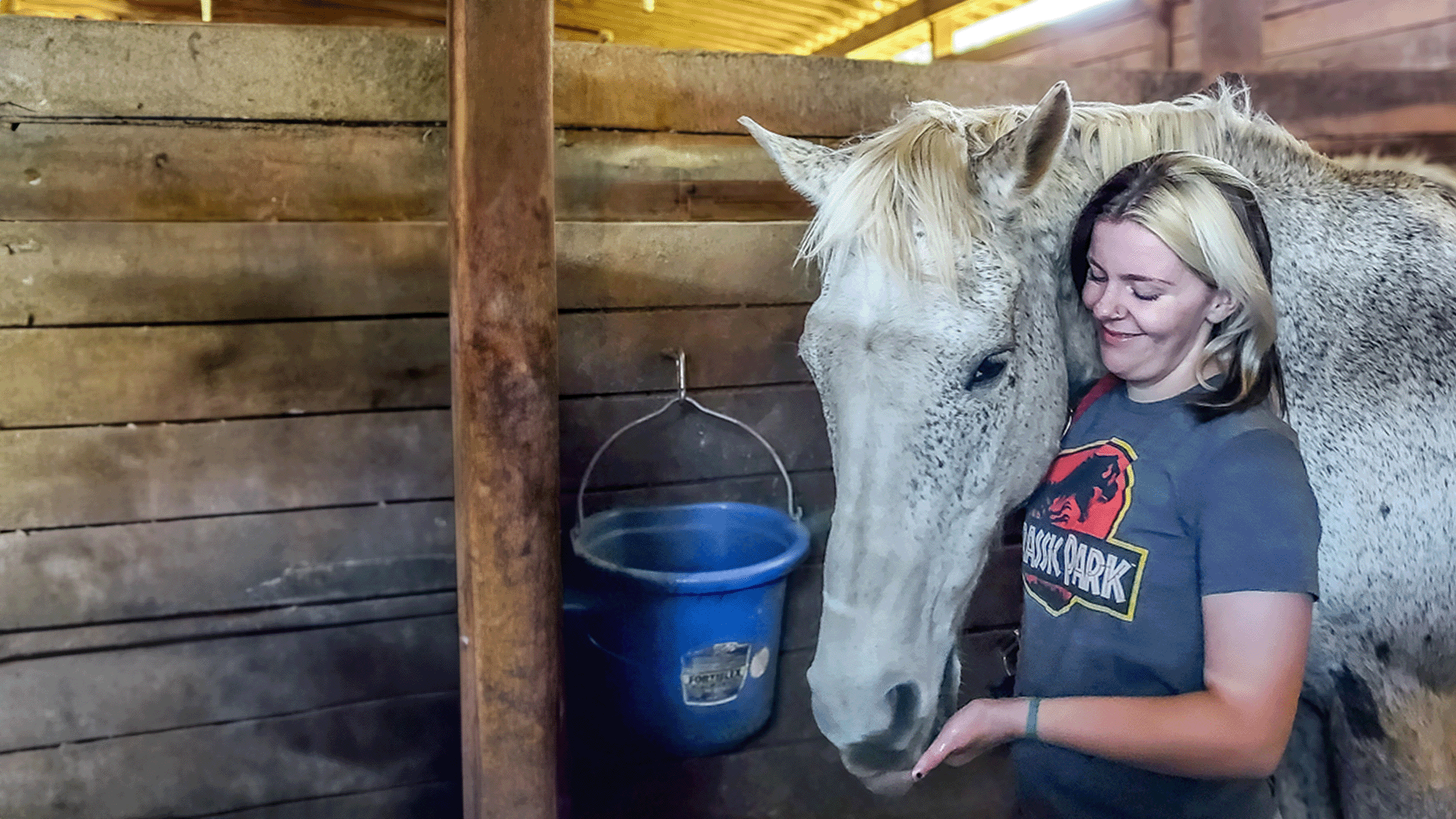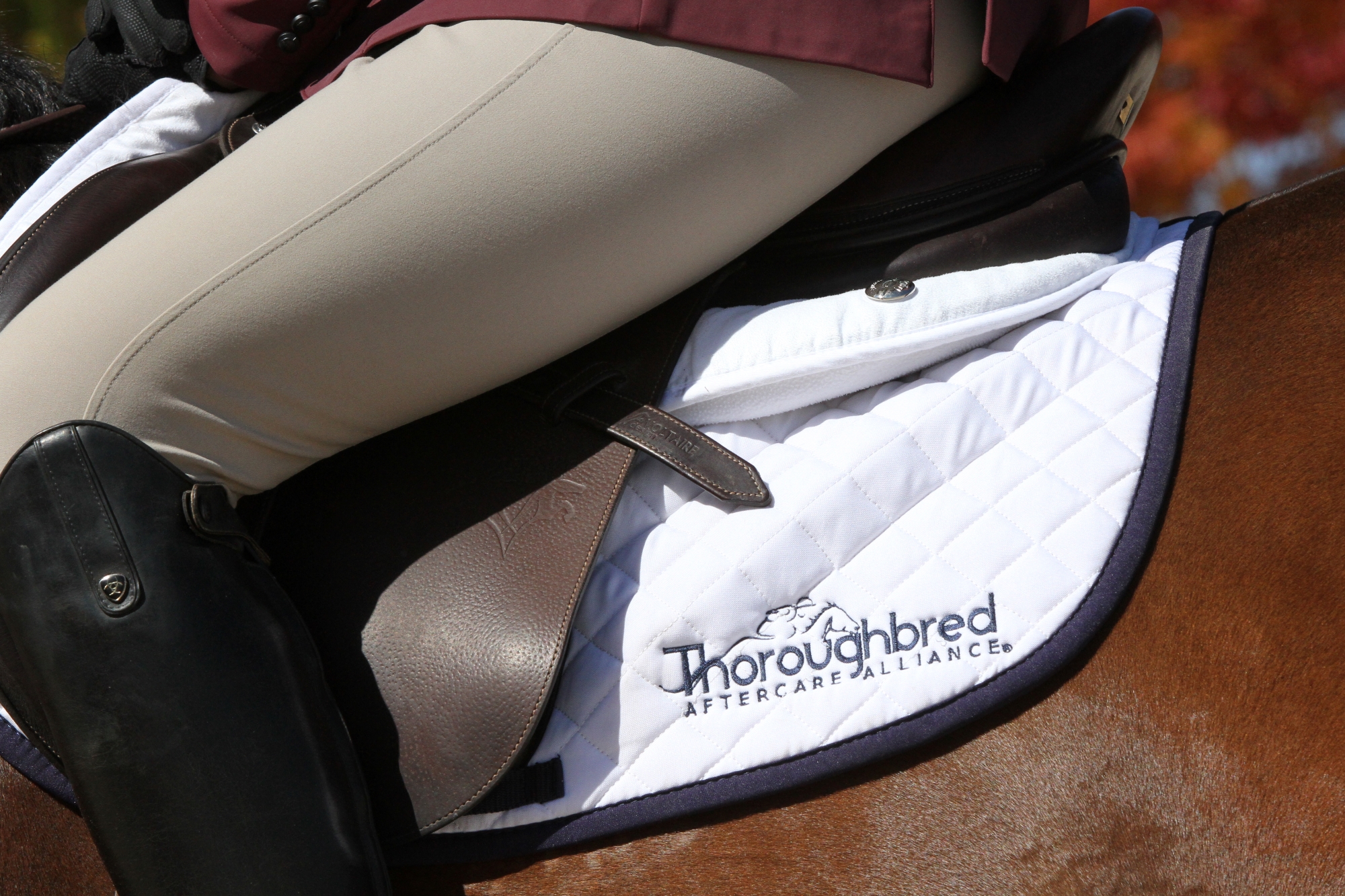Jumping
All Posts & News Press Releases Success Stories Aftercare Editorials Retraining Tips Supporter Features Inspector Spotlights Humberger Toggle Menu Previous Post rescued hearts Rescued Hearts By: Alexis Arbaugh September 26, 2024 Success Stories Tags:Accredited Organization, Brook Hill Retirement Center for Horses, Equine Therapy, equine-assisted therapy, Jumping, Thoroughbred Aftercare Alliance, United States Pony Club, USPC Misty’s Blue Knight, a 2000 grey Thoroughbred gelding, was abandoned in a field in Maryland. Thankfully, Animal Control rescued him and brought him to Brook Hill Retirement Center For Horses in Forest, Virginia. Brook Hill Retirement Center For Horses is a Thoroughbred Aftercare Alliance accredited organization that specializes in rehabilitation, retraining, adoption, equine-assisted therapy, and sanctuary for Thoroughbreds. It is also certified by the Professional Association of Therapeutic Horsemanship (PATH). Misty’s Blue Knight, affectionately known as Basil, had raced five times at Pimlico Race Course and Timonium Race Track in Maryland before being abandoned. When he arrived at Brook Hill, the staff had no knowledge of his previous training. However, it soon became clear that Basil had a new role to play at the farm: helping at-risk youth as part of Brook Hill’s Equine Therapy program. Here, Basil found a new purpose, supporting people with physical and mental disabilities. “He is wonderful with kids with mental health disabilities,” Jo Anne wrote. To everyone’s delight, Basil had been trained to jump in his past life, which allowed the young riders at Brook Hill to progress in their horseback riding skills. Along the way, Basil formed a special bond with Molly Allen, a young girl struggling with depression and anxiety. Molly chose Basil as her project horse, and their partnership became a source of healing for both. Basil, with his tendency to rush around jump courses, challenged Molly to manage her own anxiety to help Basil relax. If Molly remained calm, Basil would also have to practice being calm, but as soon as she got worked up, he would get too anxious. Their partnership has been mutually beneficial, as both have learned to control their excitement and nerves to calm each other and tackle the tasks at hand. In July 2022, Basil and Molly competed in the 2’6″ division at The United States Pony Clubs (USPC) Championships held at the Tryon International Equestrian Center in Mill Spring, North Carolina. They were joined by four teammates, each paired with their own rescue horses, as well as Brook Hill’s stable manager. This was a milestone for Brook Hill, as it marked the first time the farm had an entire team qualify for the Championships. Basil and Molly secured 6th place overall in their division, a notable achievement for both horse and rider. Their journey demonstrates how a strong partnership can provide meaningful second chances for both horses and people. Share This Article Do you have a success story that you would like to share? Submit your experience with an accredited organization here: Success Story Submission
Read More >All Posts & News Press Releases Success Stories Aftercare Editorials Retraining Tips Supporter Features Inspector Spotlights Previous PostNext Post ricky’s good luck Ricky’s Good Luck By: Alexis Arbaugh June 6, 2024 Success Stories Tags:Days End Farm Horse Rescue, Hunt Seat Equitation, Jumping, MidAtlantic Horse Rescue, Success story, Thoroughbred Aftercare Alliaince Maryland Equine Transition Services (METS) is a program sponsored by Days End Farm Horse Rescue that assists horse owners with transitioning horses to new ownership. Whether due to an owner’s inability to care for the horse or a change in interest, METS ensures that no horse is at risk of negligence. In 2022, Zoe Kostant stumbled upon an ad for Liam’s Song while scrolling through the METS page. “I saw that face in the ad and just KNEW I had to have this horse,” Zoe wrote. Liam’s Song, a 2007 dark bay Thoroughbred gelding, had a successful racing career with 36 starts across Maryland, West Virginia, and Delaware, earning a total of $239,522. When Zoe discovered the ad, it was the weekend, and METS was likely closed. Eager to learn more, she took matters into her own hands. After searching for Liam’s Song’s registered name on Facebook, she found a half lease ad from 2019, at which time he was called Titan. Zoe decided to message the poster of the ad, Emma, to see if she still had the horse. Initially, Emma was hesitant to respond, considering the time that had passed since the original post. However, once they started talking, the two hit it off. Zoe shared stories of her previous Thoroughbreds and her plans for Titan. Feeling reassured, Emma grew comfortable with Zoe taking care of the horse she loved so much. Zoe was persistent in her pursuit of Ricky (formerly Liam’s Song and Titan) because of the connection she felt just from his picture. “You can look right at him and tell he is just nothing but a lover,” she wrote. Soon after bringing Ricky home, Zoe received a call from Bev at MidAtlantic Horse Rescue in Chesapeake City, Maryland. Bev informed her that Ricky had originally come from MidAtlantic and that there was a contract stating that if he ever needed to be rehomed, he should be returned to them. Bev wanted to ensure that Ricky was in a good home, and since then, Zoe has kept in regular contact with Bev, sending updates and photos of Ricky. Despite some challenging circumstances, Ricky has been doing amazingly well. Tragically, in June 2023, Ricky and his pasture mate, Lucy, were intentionally let out of their field and both were struck by cars. Sadly, Lucy did not survive the accident, but Ricky was fortunate to suffer only minor injuries. After recovering, Ricky and Zoe began working on Hunt Seat Equitation. Although Ricky was 17 years old when he first started jumping, “that boy took to it like a fish to water!!!! He loves it,” wrote Zoe. They competed in several shows during the summer of 2023, where Ricky really shined and even took home two championship titles. Now, they continue to rebuild the muscle he lost during his time off and are looking forward to competing in locally rated shows in the summer of 2024. Share This Article Do you have a success story that you would like to share? Submit your experience with an accredited organization here: Success Story Submission
Read More >All Posts & News Press Releases Success Stories Aftercare Editorials Retraining Tips Supporter Features Inspector Spotlights Previous Post How to Teach Your Retired Racehorse to Jump How to Teach Your Retired Racehorse to Jump By: Alexis Arbaugh June 6, 2024 Retraining Tags:Friends of Ferdinand, hunter jumper, hunters, jumper, jumpers, Jumping, Retraining Tips, show jumping Alien Invasion – Photo provided by Lori Miller Lori Miller, Friends of Ferdinand Many people who adopt a Thoroughbred after it is retired from racing hope to train their horse for a second career, often in disciplines that involve jumping. Training a Thoroughbred to jump can be a brand-new experience for these retired athletes, as racehorses—unless experienced in steeplechase—don’t engage in jumping or even handling poles. Their primary focus is running on the flat and being trained for speed. Therefore, it can be challenging to teach an off-the-track Thoroughbred how to carefully and skillfully navigate a course of jumps. Lori Miller is the head trainer at Friends of Ferdinand, an organization accredited by Thoroughbred Aftercare Alliance. Located in Indianapolis, Indiana, Friends of Ferdinand specializes in retraining, rehabilitation, adoption, and providing sanctuary homes for Thoroughbreds retired from racing. Lori has extensive experience with racetracks and retired racehorses and takes pleasure in the retraining process, knowing that racehorses can have happy and healthy lives in new careers. Lori’s wealth of experience and knowledge makes her the perfect person to help fellow adopters navigate their new horse’s retraining process. It is difficult to determine if a horse will be a good jumper just by looking at them, as there are many factors to consider and different contexts for evaluation. “If you are at the track, it’s tough. A horse that races in blinkers or wears a shadow roll might be one that has a lot to think about,” Lori wrote. Horses that need to wear blinkers to focus generally have excess energy and are spooky. Lori generally tries to avoid spooky horses because it creates more problems when teaching them to jump. “I prefer the horses that will walk with confidence through whatever,” Lori wrote. Lori also considers conformation when assessing whether a horse would be good at jumping. She likes horses that seem to float when they travel, rather than stomp. She avoids horses with crooked legs, tiny feet, or a downhill build. Instead, she looks for horses that are balanced with an uphill build and correct angles. She prefers straight legs that allow the horse to stand under themselves and a neck that ties in high to their shoulders. Although there are outliers—horses with unconventional conformation that make wonderful jumpers—they are few and far between. A horse with a good attitude is always easier to work with than one that is grumpy or has a poor attitude. When asked about the kind of attitude or temperament she looks for, Lori replied that she seeks “the horse that wants to work with you, the horse that looks to the person rather than away”. A horse that wants to learn and seeks guidance from people is always going to excel. However, it is easier to evaluate a horse’s willingness after they have had a chance to settle down on a farm following their racing career. It usually takes some time after leaving the track for a horse to come out of its shell and show its true personality. “How they are at the track is frequently very different than they are away from home,” Lori wrote. Any horse that is friendly and easy to work with and around is a good start. “I want the horse to learn to go over what is put in front of it. Systematically by never asking it to do something we haven’t built up to. Teaching the horse to stay in a rhythm and not run, that there is no reason to get tight and anxious. I want my horses to learn it’s all positive”. Lori Miller Friends of Ferdinand So, now that you have your horse, how do you start jumping? Lori begins with basic flat work to ensure the horse is supple and responsive to the bit. She encourages the horse to move forward off the leg and be quick and accurate with transitions, ensuring the horse is always listening. After establishing a strong flat foundation, she introduces poles on the ground, having the horse casually walk, trot, and canter over them until they are no longer an issue. She wants the horse to get used to riding around standards, poles, and jumps in the arena, encouraging them to watch and continue working. When Lori feels the horse is ready to jump, she starts with a small jump that the horse can easily walk over. If the horse stops in front of the jump, she breaks it down to make it more inviting. “Slow work to build a confident horse,” Lori wrote. By this point, the horse is accustomed to going over poles and small boxes, so a small cross rail shouldn’t be a big deal. Their first actual jump might be a cross rail or a small log in the field, and the horse shouldn’t be fazed by it. Desensitizing your horse to various obstacles helps prevent stress or nervousness about jumping. When asked what Lori would like the horse to take away from their first jumping experience, she replied, “I want the horse to learn to go over what is put in front of it. Systematically by never asking it to do something we haven’t built up to. Teaching the horse to stay in a rhythm and not run, that there is no reason to get tight and anxious. I want my horses to learn it’s all positive”. Lori often trots over fences in the beginning stages of teaching a horse to jump. This allows the horse to learn to make a shape and stay straight while building confidence at a slower and more balanced pace. She advises against over-jumping young horses or those learning to jump, limiting
Read More >All Posts & News Press Releases Success Stories Aftercare Editorials Supporter Features Inspector Spotlights Previous Post Jonny Be Bueno Jonny Be Bueno By: Alexis Arbaugh April 16, 2024 Success Stories Tags:CARMA, Dresage, Jumping, Redwings Horse Sanctuary, Thoroughbred Aftercare Alliance The first time Marisa Isbell rode Jonny Be Bueno at Redwings Horse Sanctuary in Paso Robles, California, she could feel that he was a special horse. Even from the walk, she could tell that he was attempting to communicate with her and understand her with every leg aid that she applied. He seemed eager to converse with Marisa through the only way they could: body language. He was an incredibly sensitive horse, so he always responded right away, eager to figure out what Marisa asked. Jonny is a gray ten-year-old Thoroughbred gelding. Sired by Rattlesnake Bridge and out of Silver Spook, he had an impressive sales history. Sold first as a yearling at the Ocala Breeders’ Sale (OBS) 2016 August Yearlings sale for $55,000, then again as a two-year-old at the OBS April 2017 Spring Sale of Two-Year-Olds in Training for $80,000. Jonny then ended up in California in the fall of 2017, where he raced at Del Mar and Los Alamitos before retiring. That is when he ended with CARMA and Redwings Horse Sanctuary, beginning a new chapter with Marisa. “He is doing so well,” wrote Marisa. For the first ten or so months that Marisa owned Jonny, they did mostly groundwork. Groundwork serves as the first step in building a trusting relationship with a horse, as it allows both horse and rider to get to know each other before progressing to riding. They did so much groundwork because Jonny was extremely reactive, and Marisa could tell that he needed time to unwind. He needed to get used to his new environment and surroundings, as well as gain some confidence. Marisa started riding Jonny shortly after the ten-month mark of his adoption. “He has completely blossomed into a confident, poised, well-developed horse,” Marisa shared. Jonny, once prone to spookiness and tension, can now remain calm even in the face of heavy winds, playing dogs, and passing cows. Jonny loves the mental stimulation and consideration that comes with practicing dressage. Marisa has even started teaching him how to jump over small jumps, which he is not impressed by in the slightest. Marisa is looking forward to the continued journey of growth and partnership with Jonny. With dedication and perseverance, she aims to further develop their dressage skills. Marisa is also eager to focus on improving Jonny’s jumping technique. As they progress, Marisa hopes to compete in three-day eventing competitions, where they can showcase their combined talents and celebrate their remarkable bond. Together, they embark on an exciting journey filled with shared achievements, unforgettable moments, and the unwavering companionship that only a horse and rider can share. Share This Article Do you have a success story that you would like to share? Submit your experience with an accredited organization here: Success Story Submission
Read More >
















